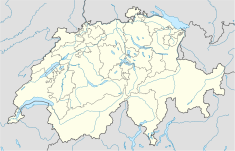- Niederamt Nuclear Power Plant
-
Niederamt Nuclear Power Plant (KKN) Location of Niederamt Nuclear Power Plant (KKN) Official name Kernkraftwerk Niederamt Country Switzerland Location Niederamt, Canton of Solothurn between Olten and Aarau Coordinates 47°21′57.4″N 7°58′27.2″E / 47.365944°N 7.974222°ECoordinates: 47°21′57.4″N 7°58′27.2″E / 47.365944°N 7.974222°E Status planned Owner(s) Kernkraftwerk Niederamt AG Operator(s) Kernkraftwerk Niederamt AG Reactor information Reactors planned 1 x 1,100–1,600 MW Website
www.kkn-ag.chAs of 23 October 2010 The Niederamt Nuclear Power Plant (in German Kernkraftwerk Niederamt, abbreviated to KKN and not to be confused with the similarly abbreviated Niederaichbach Nuclear Power Plant) is the name for a planned nuclear power plant near the existing Gösgen Nuclear Power Plant in Niederamt in the Canton of Solothurn between Olten and Aarau in Switzerland. The land earmarked for the project will take in some of the residential areas of Niedergösgen, Gretzenbach and Däniken.
Contents
History
On 9 June 2008 the Kernkraftwerk Niederamt AG, a project company of Atel Holding AG, which now goes by the name of Alpiq Holding, submitted the general licence application to the Swiss Federal Office of Energy.[1]
This is the first stage of the licensing procedure for a new nuclear power plant in Switzerland. The general licence application consists of six documents: the safety report; the environmental impact report; the security report on protection from external hazards; the demonstration of disposal feasibility; the concept for decommissioning, and the report on conformity with the land-use planning.
The general licence is issued by the Swiss Federal Council. Following the natural disasters in Japan, which resulted in the reactor accidents at the Fukushima nuclear power plant, on 14th March 2011 Federal Councillor Leuthard suspended the general licensing procedures for the replacement of existing nuclear power plants.[2] The suspension will remain in force until the causes of the accident in Japan have been analysed and the safety standards of Swiss nuclear power stations have been reviewed and adapted in light of the new findings.
Project information
The general licence application does not refer to any specific plant. It is based on a generic nuclear power plant of the third-generation designs available today with light water reactors (pressurised or boiling water reactors) but stops short of specifying the actual make or manufacturer. More detailed information will only be required for the construction licence application which cannot be submitted until the general licence has been granted.
The application is therefore based on two output categories, 1100 megawatt and 1600 megawatt.
No decisions have yet been made as to the exact dimensions, design and positioning of the reactor building, power house and cooling tower within the context of the project. An approximate height of 75 metres can be assumed for the reactor building. The plot measures approximately 130x180 metres.
The means of cooling would be a hybrid cooling tower of about 60 metres in height with plume abatement. The estimated building costs are six to eight billion CHF, i.e. between four and six billion euros.[3] The power station will create up to 3000 jobs during the construction phase and will employ some 400 to 500 people once in operation. The reactor, which is to be selected at a later stage in the process, should be a field-tested reactor and not a prototype.
Planning approval process and timetable
The planning approval process is subdivided under the Swiss Nuclear Energy Act[4] into three licensing procedures: the general licence, construction licence and operating licence.
The general licence procedure involves identifying the holder of the authorisation and specifying where and for what purpose the plant is to be built. Other basic information needs to be recorded, such as the output category and the main cooling system. The general licence will be granted by the Federal Council. The licence granted by the Federal Council must then be approved by the Federal Assembly (this process takes about one year). There can be a referendum to appeal against the licence approved by the Federal Assembly.
Once the general licence has been granted, the next step is to apply for the construction licence.[4] The construction licence is granted by the Federal Department of the Environment, Transport, Energy and Communications if the protection of the population and the environment are fundamentally guaranteed, if the project is consistent with the principles of nuclear safety and security, if the project does not conflict with any other government legislative provisions (environmental protection, nature conservation, homeland security, land-use planning), if due and proper execution of the project can be guaranteed, and if a programme of quality control measures for all construction work is in place as well as a plan for decommissioning. The Department sets a deadline in the licence for the start of the construction work.
Building work can commence on the nuclear power plant on receipt of the construction licence. The construction phase will last between four and six years.
Before the new nuclear power plant can be put into operation it is necessary to obtain the operating licence in the relevant licensing procedure.[4] The operating licence is also granted by the Federal Department of the Environment, Transport, Energy and Communications.
See also
References
- ^ Atel submits application for general licence of new nuclear power plant Niederamt in Solothurn, Atel Holding AG, June 10, 2008
- ^ Federal Councillor Leuthard suspended the general licensing procedures for the replacement of existing nuclear power plants, DETEC, 14th March 2011
- ^ WNA - Nuclear Power in Switzerland
- ^ a b c Swiss Nuclear Energy Act
External links
Nuclear power in Switzerland operating at the planning stage Niederamtclosed mothballed Graben · Inwil · Kaiseraugst · Rüthi · Verboisopposition Categories:- Nuclear power stations with proposed reactors
- Nuclear power stations in Switzerland
Wikimedia Foundation. 2010.

